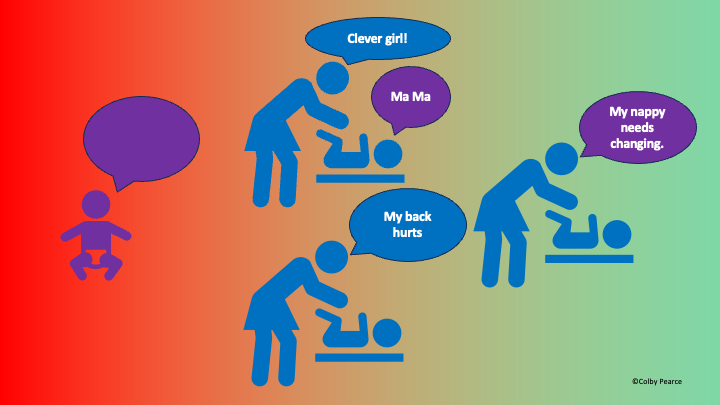
As background to this topic, it is important to review how it came to be so that young people recovering from a tough start to life might communicate through their actions, and why it is important to think about their behaviour in this way.
Children learn to communicate with words in a care environment where their caregivers:
1. Acknowledge their attempts at communication,
2. Speak the words that go with the child’s experience, and
3. Use words to communicate about their experience.
Regarding the first of these, children learn words in a caregiving environment where, in amongst their babble, their caregivers respond with joy and encouragement when they babble something approximating a word. For example, think about the reaction of the mother when their infant first babbles “Ma” in a conventional nurturing care environment. The mother communicates joy and encouragement to the infant. Through the emotional connection that is in place in such moments, the infant experiences a corresponding positive emotion that reinforces their vocalisation of “Ma” when orienting to their mother. As time passes, the infant babbles other approximations of words and is similarly acknowledged and reinforced for those vocalisations over others that do not sound like words to their parent. In this way, the infant begins to express sounds that lead to a response from their parents over sounds that do not.
In addition, in a conventional nurturing care environment parents can be observed to speak to their infant with ‘their voice’. That is, the parent says out loud what their infant is believed to be thinking or feeling, or what they need from the parent. If you are unsure of what I am talking about and have a pet, think about the way in which you speak to them. Through many such interactions, the infant begins to learn what words go with their experience and needs. When able to do so, the infant uses these words and, in conventional circumstances, is acknowledged with joy and pride at having done so, thus increasing the likelihood that they will use their words again.
Further, in a conventional nurturing care environment, the infant observes their parents using language to communicate about their experiences and their needs. In such an environment, the infant learns to use words to communicate about their experiences and needs via parental modelling.
In combination, these three aspects of the infant’s care environment support the development of language to communicate, and its use.
Click here to enter the next page of this module.
To go back, click here.
To access the handbook for this self-paced learning module, click here.
